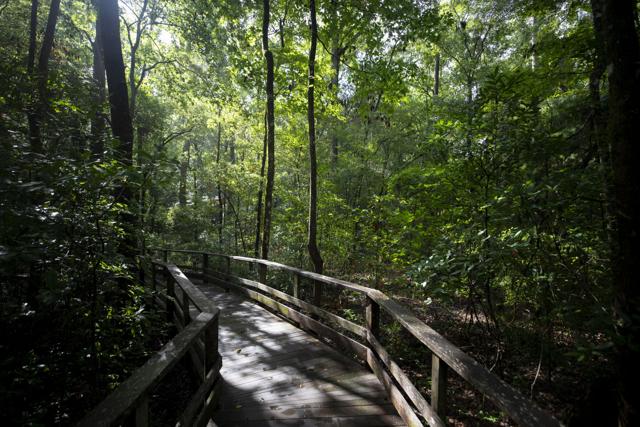from The Post and Courier

Sunlight casts across the boardwalk leading into the Francis Beidler Forest, Thursday, July 17, 2025, in Dorchester County.
In the Francis Beidler Forest, trees silently mark the passage of centuries. The heart of this ancient woodland has remained unchanged for thousands of years.
“It’s exactly the same today as it was prior to any European contact,” said Tim Evans, the director of land conservation at the Beidler Forest Sanctuary, a site in Dorchester County which is overseen and maintained by Audubon South Carolina. “That forest is exactly what was here before anybody even knew there was an ‘America’.”
Beidler once was part of an untamed wildland that stretched across the state. As European settlers arrived, the primal cypress-tupelo forests were carved away. Woodlands gave way to farms, roads, parking lots and subdivisions. But this forest endures.
“The central core of the forest has never been cut, it’s never been cleared, it’s never been logged,” Evans said.
But change might be coming to one of South Carolina’s most ancient forests. Santee Cooper, the state-owned power utility, has proposed a plan to construct a new power line on an existing right-of-way through Beidler.
Santee Cooper’s current right-of-way, which includes an existing power line, is roughly 125-feet wide. Kate Mixson, a senior attorney with the Southern Environmental Law Center, said about 100 feet of that is currently clear-cut, and the new line could involve cutting down plant life in the extra 25 feet, which she said is currently forested.
“ We’re talking about a utility deciding to cut down parts of this forest for the first time in all of human history,” Mixson said. “There has to be a better option.”
The Law Center is intervening in Santee Cooper’s proposal, which is under consideration by the state’s Public Service Commission.
Officials at Audubon say the plan could cause irreparable harm to some of the sanctuary’s oldest trees and the vulnerable wildlife the forest supports.
The utility argues the new line is an essential piece of infrastructure to bolster the electrical grid in the rapidly growing Berkeley-Charleston-Dorchester tri-county their profits and can be done [but probably won’t] without endangering old growth areas. The utility wrote in its application to state utility regulators that the new line will have “no significant adverse impact” on wetlands/streams, flood zones, land cover, wildlife, protected species or cultural resources.
Santee-Cooper could remove trees that might fall on the planned transmission line, which would be built adjacent to the old one. The utility might need to remove trees within an additional 100 feet on either side of the right-of-way if they pose a risk to the line, according to a Public Service Commission document shared with The Post and Courier.
“Beidler is important precisely because it has been allowed to exist mostly free of human influence,” Mixson said. “It would be a real travesty for it to survive all of these years just for parts of it to be removed because someone put a transmission line through it in the 1940s, long before we understood just how rare this type of place would be 80 years later.”
Despite its age, Beidler has a delicate ecosystem. In the oldest part of the forest, visitors can walk through the sanctuary — but they can’t walk on it. Elevated wooden paths, which Mixson said were built without uprooting a single tree, help protect the undercarriage from human destruction.
The transmission line project would run just a few hundred feet from that oldest part of the forest.
Article continued here
